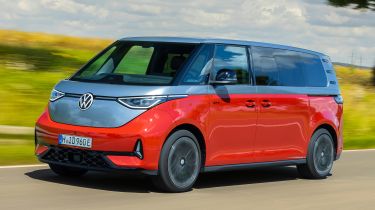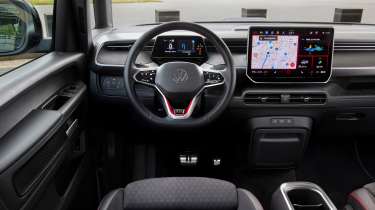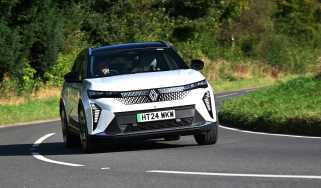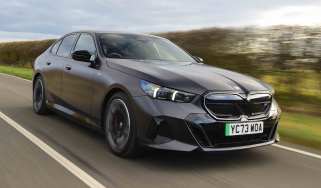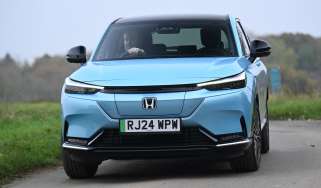New Volkswagen ID. Buzz GTX 2024 review: fails to live up to its flagship status
The hot Volkswagen ID. Buzz GTX packs 335bhp, but looks set to cost around £70k

Verdict
A new top end to an already expensive model range, the Volkswagen ID. Buzz GTX only really makes sense if you need four-wheel drive, or plan on towing with it. The standard ID. Buzz – especially with the power upgrade coming later this year – is fast enough for a big and tall vehicle, and apart from being quicker in a straight line, the GTX upgrades are cosmetic. It is a bit nicer inside and you get more kit, but the smart money is the long-wheelbase seven-seater arriving in late 2024.
Volkswagen’s range-topping electric car has a new flagship version, with the arrival of this ID. Buzz GTX. The GTX branding, already seen on the ID.4 and ID.5 and coming soon to the ID.3 and ID.7, is a more powerful alternative to the regular models, though not a full-on electric GTI. So more power and some better equipment levels, but nothing to make it quicker around corners.
The Buzz is already unlike anything else on sale, with its head-turning retro styling, huge space and practicality, and hefty price tag. The GTX lifts two of those three elements; the looks courtesy of some new alloy wheel and colour options and interior upgrades, and the price – estimated (but not finalised) to be over £70,000. That’s at least £6,000 more than the Style trim that tops the regular Buzz line-up.
More reviews
Car group tests
- Volkswagen ID. Buzz vs Lexus LM: which is the best fancy family car?
- Volkswagen ID. Buzz vs Tesla Model Y: 2023 twin test review
In-depth reviews
Long-term tests
Road tests
VW hasn’t yet revealed the numbers that really matter for an electric car, with range and efficiency data still under wraps. But it has confirmed a 335bhp power figure that takes the GTX from 0-62mph in 6.1 seconds, which is 1.8 seconds faster than the regular Buzz’s 282hp electric motor can manage. An official range figure of around 260 miles is expected, which should equate to just over 200 miles in the real world.
And in that real world, it only takes as far as the first roundabout to understand that this isn’t a Buzz GTI. That’s no surprise, given there aren’t any suspension or engineering improvements to go with that power hike, but it’s good to emphasise that there’s no semblance of a sporty drive to the Buzz GTX. It doesn’t even feel that rapid, although the fact that it weighs well over 2.5 tonnes does predictably blunt the performance somewhat.
It accelerates evenly, but just doesn’t feel like it’s got that instant punch of performance that a lot of higher-powered EVs can offer. It’s pleasant enough though, and the GTX-exclusive 21-inch wheels don’t do anything to harm the comfortable urban ride quality and a level of manoeuvrability that belies the hefty dimensions.
Also exclusive to the GTX is the new Cherry Red paint colour that’s possibly the Buzz’s best option yet, especially when combined with silver for the optional two-tone finish. The GTX is also marked out by some high-gloss black trim on the lower part of the front-end, while on the inside it’s a little bit swankier in some places, while still having plenty of solid and scratchy plastics in view – certainly more than you’d expect in a £70k car.
The steering wheel and seats get GTX logos, and there’s some nifty red detailing in a little nod to the higher-performance potential of the Buzz GTX. It’s nice, although it’s no tartan seating a-la VW’s legendary GTI models. A new panoramic sunroof – a first for the Buzz and the largest one developed by VW – is an option, and really boosts the amount of light coming into the cabin for those in the rear seats. That said, the huge windows already do a good job of making the spacious cabin feel bright and airy.
The infotainment, a weak point on the existing ID. Buzz, has been improved for the arrival of the GTX (and the regular ID. Buzz LWB car), with an upgrade taking the screen from 12 to 12.9 inches and finally illuminating the temperature and volume slider bar underneath the screen. It’s still not particularly responsive or quick to load up, but it’s a step in the right direction at least.
Bizarrely for an even lightly-performance-branded model, what you can drag behind the ID. Buzz GTX is an important part of its appeal. The four-wheel-drive GTX can tow a maximum weight of 1,800kg, which is 600kg more than the single-motor Buzz. Start pulling anything heavy and the range will shrink rapidly, but it’s a useful string to the bow, and a pretty high towing figure for an EV. That four-wheel drive traction could also be useful for some.
The ID. Buzz GTX is a bit of an oddball, then. It’s faster but doesn’t feel significantly punchier than a regular Buzz, it looks subtly better without being overtly sporty, and it’s no better than a regular Buzz to drive. VW’s electric MPV is already pretty pricey when compared to something like a Kia EV9, and the GTX doesn’t really bring enough to the party to justify the extra outlay.
At the moment the idea is to only bring the short-wheelbase GTX into the UK, but the long-wheelbase seven-seater, which wasn’t part of the original plan, could be set to get the green light. The regular LWB model, with its seven-seat capability and extra space, only costs £510 more than the shorter car, so if the GTX LWB comes in, it’ll be the logical choice.
| Model: | Volkswagen ID. Buzz GTX |
| Price: | £70,000 (est) |
| Powertrain: | 79kWh battery, 2x electric motor |
| Power/torque: | 335bhp/TBC |
| Transmission: | Single-speed automatic, four-wheel drive |
| 0-62mph: | 6.1 seconds |
| Top speed: | 99mph |
| Range: | TBC |
| Max charging: | 185kW, 10-80% in 26 minutes |
| Size (L/W/H): | 4,712/2,211/1,927mm |
| On sale: | Late 2024 |

